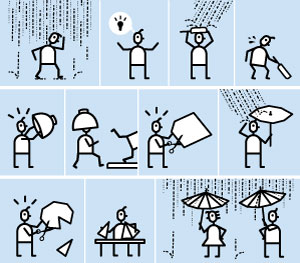Whether you’re developing a new product or a presentation, it’s common to perfect your work and then share it with the world. But this “big reveal” approach can set you up for failure. Instead, try an iterative design process—make a quick draft or prototype, test it, and then refine it. With this approach, you “fail forward,” learning what works and what doesn’t during each phase of your project. Iterative design works best for projects in which the solution isn’t clear or you don’t know how your audience will react.
Here are some tips for iterating your ideas into successful products.
1. Build a prototype fast.
With an iterative design process, you don’t want to spend too much time making and perfecting your deliverable. You want to test it as soon as possible. So build a cheap prototype with masking tape and chopsticks. Draw with markers on a cardboard box. The point is to give people something to react to so you can gather their feedback.
2. Solidify big chunks.
What is the most crucial part of your project? If you’re writing a speech, it may be the main idea. If you’re building a mousetrap, it may be the trapping device. Whatever it is, test that first. It will save you from embarking on a big project in which the concept is flawed. Once you feel confident in the biggest part of your project, move on to the smaller parts.
3. Embrace informal testing.
“Testing” your prototype can be as simple as asking friends, relatives, or colleagues for their input or watching as they use your prototype. The goal is to get feedback fast, so there’s no need to hire a focus group yet. Consider using quick, inexpensive tools like social media or online surveys to solicit opinions.
4. Aim to fail.
If you don’t have something to fix after each draft, you’re not doing it right. With iterative design, you’re not looking for confirmation that your idea is great and your design is brilliant. You want to know what’s wrong so you can make it better. It doesn’t matter how beautifully your solar toaster is designed if the testers store it in a dark cabinet.
5. Finish when it’s “good enough”.
There’s always room for improvement, but at what cost? Don’t sink too much time, money, or resources perfecting a project when you can get feedback from paying customers. The truth is that your creation will always be in some form of revision — that’s why we have software updates, “new and improved” products, and revised textbooks. Share your product with the masses. Then start working on 2.0.
First published in Design Goggles, our seven-part series in TEQ Magazine (p.40).

